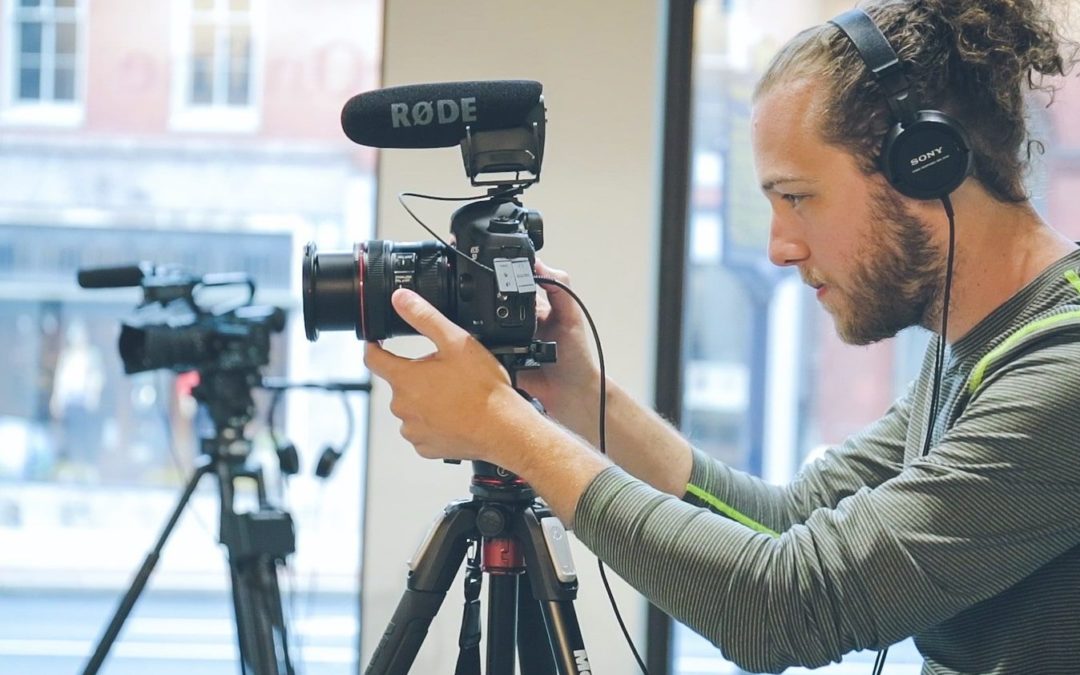Adults over 50 years of age are a prime audience for many businesses, including retirement communities, financial planners, insurance agencies, health care providers, retail shops, travel agencies, restaurants, and many more. Older adults have disposable income and the free time to spend that money. Plus, there are a lot of people in the 50+ age bracket – about 200 million according to the US Census Bureau.
This article will provide an overview of traditional and digital marketing strategies to reach older adults, especially those in Lancaster County, Pennsylvania and surrounding counties such as York, Lebanon, Berks, Chester and Dauphin.
First, this article will review traditional marketing channels that are most important for reaching older adults, then this article will review specific digital targeting strategies that help businesses find adults 50+ wherever they may be on the internet.
Traditional marketing channels to reach the 50+ demographic
Newspapers
The average age of newspaper readers is about 57.9 years according to Nielson Scarborough, making newspapers one of the very best ways to build brand awareness with seniors. Locally, LNP newspaper commissioned an independent market research study that found that about two-thirds of their paid subscribers are 55+, making LNP a highly targeted channel for reaching older adults in Lancaster County.
Newspaper marketing has powerful benefits: you get broad reach, you can ensure exclusivity within news sections, and your ad appears alongside trusted local news stories. All these aspects are particularly important for the 50+ demographic since they were raised in an era when newspapers were the dominant source of information, long before the advent of websites, smart phones and social media. For older adults, newspapers remain a source of reliable, trusted news content. Advertising in the newspaper associates your brand with those feelings of trust and reliability.
Newspaper special sections
Most newspapers publish regular special sections which offer deep dives into specific topics of interest to older adults. Typical topics might include health care, home improvement, senior living, or travel. Advertising alongside this type of content is especially important if the products and services of your business align with the special section content. For example, a special section on home improvement would be logical choice for a business offering roofing, HVAC, plumbing, building services, kitchen/bath renovations, flooring, painting/drywall, window treatments, lawn care, hardscaping, furniture or interior design.
Lifestyle magazines
Many newspapers also publish lifestyle magazines which cover topics such as wellness, fashion, food trends, home, and garden. This type of lifestyle magazine retains the trusted voice of local news media while showcasing content that isn’t normally presented in regular newspaper pages. Businesses get a unique opportunity to present their business in the form of sponsored content (storytelling about your business) with great photography on glossy paper. This approach is not offered in the regular pages of the daily newspaper.
Direct mail
Direct mail reaches the home, has a long shelf life, can be personalized, and is very influential. A research study by Temple University and the US Postal Service found that direct mail recipients were strongly likely to remember the content of printed ads and had a strong emotional response to printed ads. Direct mail is essentially a printed ad that is delivered to the mailbox. For older adults, direct mail is familiar, personal, tactile, and non-intrusive, which are all important attributes when communicating with this demographic.
While you can send direct mail to a list of customers or prospects that you already have, most direct mail providers also offer targeted lists for purchase. These lists can be selected based on location plus demographic attributes like age, income, marital status, home type, home value and more. Direct mail list vendors also offer interest-based targeting. An example of interest targeting for adults 50+ would be an interest in golfing or crafting.
Digital marketing channels to reach the 50+ demographic
Research shows that not only do seniors (and their adult children) want to become familiar with a product or service before purchasing, going online is a popular way to do that kind of research.
Take a look at the following facts that dispel the senior/anti-tech stereotype:
Unlike traditional marketing, digital marketing’s value is not inherent in the content or the platform. Digital marketing is valuable for its own set of unique benefits when marketing to older adults. Most notably, digital marketing offers:
- Refined analytics
- Precise targeting (see our blog post on digital targeting)
- Reliable success measurements
- Budget-friendly options
- Increased exposure
Across all digital platforms, there are three general categories of targeting:
- Demographic (location, age, income, gender, etc.)
- Behavioral (sites/apps that users have visited, or their status as a customer).
- Interests (inferred information about users’ interests based on their behavior)
While these overall categories are consistent across all platforms, there are differences in the details. Below is an overview of the targeting options in each of the major digital channels that will allow your business to reliably reach the 50+ demographic.
Social Media – Facebook and Instagram
Facebook ad campaigns (which include Instagram) have four levels of targeting to help you reach older adults:
- Demographic – This includes targeting by age, which is an excellent tool for reaching your businesses’ desired older adult age group. You can also use Demographic targeting to select your ad’s audience by gender and location.
- Behavior and interests – Facebook’s list of behaviors and interests is huge. Using this targeting feature for older adults simply requires that you have a clear idea of the interests of the particular type of older adults you want to reach. For example, under Entertainment targeting, older adults are less likely to be reached by selecting Massively Multiplayer Online Role-Playing Games, and more likely to be reached by selecting Word Games. If you know what your audience likes to do, this targeting feature can be very effective.
- Custom – This option is for retargeting people who have already interacted with your brand. For example, a custom audience could be created to target people who have visited your website, added your company’s items to their shopping cart, or interacted with your company’s app. To create a custom audience, you can also upload a csv or txt file of your customers and then Facebook will use this to target your ads.
- Lookalike – Once you have created a Custom Audience you can leverage it to find people with similar behaviors and interests. Facebook provides a sliding scale so that you can define how similar the Lookalike audience needs to be to your Custom Audience. If the current customers you used for your Custom Audience are older adults, using Facebook’s Lookalike targeting is a great way to find more older adults who are similar.
Social Media – LinkedIn
LinkedIn is the #1 platform for businesspeople to connect with each other. If your target audience is older adults who are retired, then LinkedIn may be less relevant to your campaigns because the further people get from the workforce, the less likely they are to actively engage with LinkedIn.
However, if your desired audience is still in the workforce, LinkedIn’s ad manager has some powerful and unique capabilities to help you reach older adults.
- Demographics – LinkedIn allows targeting by age, which you can use to reach older adults, plus gender and location. While demographics are a standard targeting feature across all digital channels, the following four targeting options are unique to LinkedIn.
- Job Experience – Target your ads by job functions, seniority, titles, years of experience and skills. This is also relevant to targeting older adults based on attributes like seniority and years of experience.
- Education – This includes degrees, fields of study, certificates and schools.
- Company – This includes company name as well as corporate attributes, such as growth rates and size.
- Interests and Traits – Member interests, traits and groups (relevant to peoples’ skills, careers, and education) are all targetable with this category.
Social Media – YouTube
YouTube is a video-centric social media platform owned by Google. Your business’s ads on YouTube should be short videos that auto-play before, or in the middle of, YouTube content videos. It is possible to use a static image in a YouTube video ad spot but it is not recommended because you would lose the inherent power of communicating via video to a video-focused audience.
YouTube has a comprehensive list of targeting options. The most important ones for reaching people who are 50+ include:
- Demographics – This includes geography, age, household income, parental status, and gender. These are all excellent choices for defining the older audience you want to reach.
- Interests – Use this type of targeting when you know what your specific 50+ target audience is interested in. Interests include topics such as avid investors, cooking enthusiasts, frequent salon visitors, etc.
- Customer Match and Similar Segments – As with Facebook, YouTube allows you to target people who have already interacted with your website or apps, and also allows you to reach your current customers based on uploading a list. Further, YouTube can create lookalike audiences who are similar to your current customers or website/app visitors.
- YouTube search history – YouTube allows you to target your ads based on the search history within YouTube. So, for example, you could target people who have searched for videos on “European river cruises”.
- Competitor Channels – If your business has a competitor with a robust YouTube channel that is relevant to a 50+ audience, you can target that channel to serve your ads. This is a great way to get your products and services in front of an audience that is already consuming video content that aligns with their interests.
Targeted Display
Targeted display ads are served on the Google Display Network, which is comprised of over 2 million websites, videos and apps. It’s huge. Targeted display campaigns harness many of the same targeting options as other digital campaign types, including:
- User based targeting – Location, demographics, interests, and affinities. User based targeting shows ads to a set of users, regardless of what websites or apps they are using. User based targeting is easy to use for reaching older adults.
- Website-based targeting – Select specific groups of websites where you would like your ads to be displayed. This approach shows your ads to all users on the targeted websites. So, in this case, you’d want to select websites where you are confident that there is a high proportion of older users. Or, you can select specific types of content or keywords relevant to your business.
Targeted display also offers targeting options such as remarketing (serving ads to people who have visited your site), similar audiences (people who are similar to your current customer list), and in-market (users whose behavior online has shown that they may be in the market for a particular product or service).
Two other very powerful targeting options within Google Ads are Custom Intent Audiences and Custom Affinity Audiences.
- Custom Affinity Audiences are essentially a customized version of Google’s standard affinity targeting options. You layer on additional attributes (like keywords) to define an audience that aligns with the interests of your customers.
- Customer Intent Audiences use multiple factors to determine that a user is in the market for certain products and services. The factors might include that users have visited your competitors’ websites, or that they are using certain search terms or keywords, or that they have watched certain types of YouTube videos. Custom Intent Audiences harness the power of your users’ actual behavior to find the people who are most likely to want your business’s products and services.
Paid Search
Paid search ads are shown when users use a search engine, like Google or Bing, to search online for products and services. With paid search, your business bids on certain search terms (or keywords) that are relevant to your business. For example, if your business sells golf clubs, you’ll want to bid on search terms relevant to people who are shopping for golf clubs (e.g. “5 iron for sale in Lancaster PA”). These ads are powerful because your ad will be reaching people who have just demonstrated that they are looking for exactly what your business is selling.
There are different types of paid search ads from which to choose. For example, there are shopping ads which display one of the actual products in your e-commerce store (e.g. golf clubs) and click right through to the product page. And there are text ads, which appear within users’ text search results, with the word “sponsored” displayed above. And there are local listings, which appear next to a little map on the search results page, showing where relevant local businesses are located.
Geo-fencing
As the name implies, geo-fencing is location-based targeting. With geo-fencing, your business’s ads are served to people on their mobile devices, based on their interaction with a geographic perimeter that you define. When the person passes the geographic perimeter with their mobile device that has location services enabled, their phone is tagged as qualified to receive your business’s ads.
The value of geo-fencing is the tight radii that can be defined. For example, if your business offers financial services to seniors, you could fence local retirement communities. Other types of businesses, such as car dealerships, can fence their competitors to target people who are actively searching for a new car. Or, if there is a bridge competition at the local convention center, you can fence that area to reach what is, presumably, an older audience of bridge players.
Geo-fencing ads have about double the click-through rate of regular digital display ads making them an excellent digital tactic when you have defined location information to harness.
Digital marketing channels that are less useful for the 50+ demographic
TikTok, Twitter, and Snapchat are three social media channels that have fewer older users than other digital channels. Here is the percentage of users 50+ on each of the major social media channels:
- LinkedIn – 33%
- YouTube – 23%
- Facebook – 22%
- Twitter – 17%
- Instagram – 14% (included with Facebook campaigns)
- TikTok – 7%
- Snapchat – 4%
Source: Statista.com
Twitter has recently had issues with user trust due to changes in Twitter’s user verification process. Until these issues shake out, businesses may want to avoid Twitter because of the risk of showing an ad alongside content that is antithetical to the business’s mission.
Snapchat and TikTok don’t have a user trust problem, but they are youthful platforms with a small percentage of senior users, and thus not the most productive place to market to an older demographic.
Digital Targeting – Final Tips
In summary, there is a vast array of options available to target 50+ adults via digital channels. However, an important tip to remember is to be careful not to over-target. Over-targeting can result in whittling down your potential audience to such a narrow slice that you miss out on reaching qualified people. Best practice is to start with geographic targeting plus one or two other targeting options that you feel are the most important. Then, see how the campaign performs before testing additional layers of targeting.
Don’t think of digital vs. traditional marketing as “either-or.” The right answer is both.
Think about how you want to allocate your advertising dollars to attract 50+ consumers; the most effective plans use the best features of both digital and traditional together to build awareness, create engagement and generate sales leads.
LNP Media Group offers a full array of successful print and digital strategies. Contact us to learn more about how to reach older adults, or any other target audience, through both traditional and digital media.





